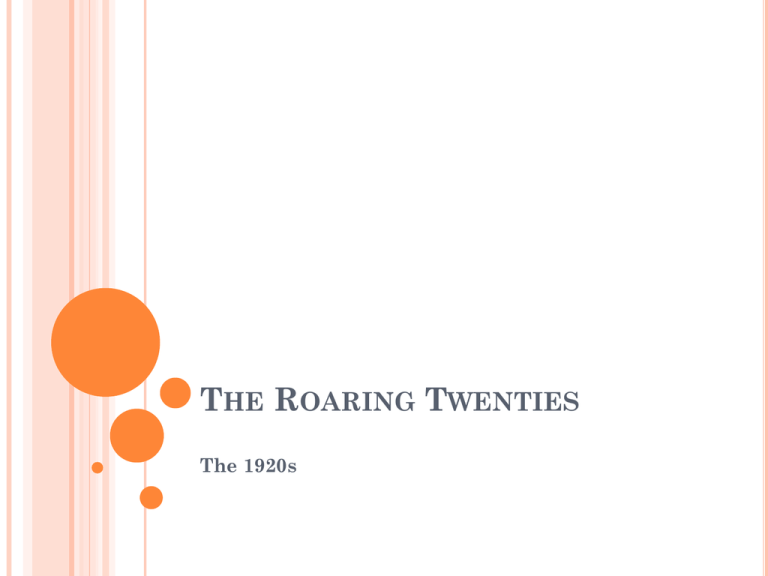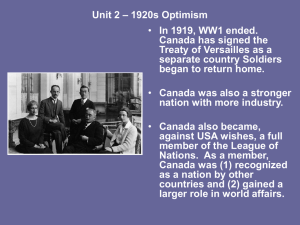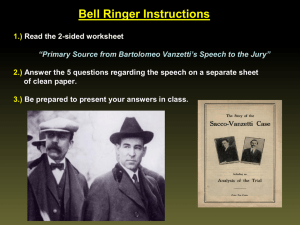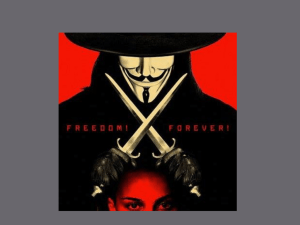
THE ROARING TWENTIES
The 1920s
1920S SLANG
The 1920s was a colorful decade in both Europe
and America, sandwiched between the hardships
of the two World Wars. Especially in the United
States, the 1920s was also accompanied with a
dizzying amount of slang, most of which was used
by young people. Many phrases from 1920s slang
are still used in modern English, as is the case
with terms like “baby” for sweetheart, “necking”
for making out, “john” for toilet, and “Joe” for
coffee. Others have faded into obscurity, only to
be revived in films and books which celebrate the
1920s.
SLANG
1920s slang is often related to alcohol and having
a good time, since Prohibition put a premium on
both of these things. The slang also reflects
changing morals and ideas, especially
surrounding sexuality. Flappers, young women
who enjoyed risque garments and late night
dancing, abounded, as did daddys, wealthy older
men, to support them. Many 1920s slang terms
also suggest a sense of fun and mischievousness,
both of which ran rampant during the 1920s.
SLANG
An attractive woman in 1920s slang was a Sheba,
while a man was a Sheik. The two might spend a
night on the snuggle bunny, the back seat of a
car, assuming neither upchucked from drinking
too much hooch. A woman might also put the
brakes on the proceedings by declaring “the
bank's closed,” or she might be a wet blanket and
want to go home early. People who stayed out
late were known as owls in 1920s slang, a term
which has endured to this day.
SLANG
Something particularly excellent might be the
bee's knees, the cat's pajamas, or the cat's meow.
A woman might get dolled up in her glad rags for
a late night on the town, meaning that she put
some care into her appearance and wore her
nicest garments. After a blind date, one or more
participants might carry a torch for the other,
assuming that no one got smacked in the kisser,
or mouth. Being a good hoofer, a dancer, was also
a valued trait.
SLANG
Given the criminal atmosphere of the 1920s, it
should come as no surprise that many 1920s
slang terms were related to criminal activity.
Someone might be on the lam from the fuzz,
indicating that they were avoiding the police, or
“on the level,” for law abiding and reasonable. In
a hairy situation, someone might become the fall
guy, taking the punishment or being framed for a
crime. When a joint or club was raided, the
celebrants would usually scram in an attempt to
avoid being penalized.
SLANG
In 1920s slang, an establishment might be ritzy,
like the hotel chain, meaning that it was
extremely nice. People were advised not to take
any wooden nickels, a colorful way to say “don't
be stupid,” and stragglers would be exhorted to
“get a wiggle on” for “get moving!” And, of course,
people were reminded to “mind your own
beeswax” if they got too nosy.
SLANG
The long-term endurance of many 1920s slang
terms may be related to a general glorification of
the era. It is probably also due to the fact that
the 1920s marked a distinct change in attitudes,
especially for young people, and it paved the way
for many other things, from the spread of jazz to
the women's liberation movement. Thus, the
neologisms of the 1920s hold particular
resonance since many of them describe new
concepts.
SLANG TERMS YOU NEED TO KNOW
Applesauce- an expletive same as horse
feathers, as in "Ah applesauce!
Bank’s Closed- no kissing or making out - i.e. "Sorry, Mac, the bank's closed."
Bee’s Knees- An extraordinary person, thing,
idea; the ultimate.
Breezer: a convertible car.
Berries- That which is attractive or pleasing;
similar to bee's knees, as in "It's the berries."
Cat's Meow- Something splendid or stylish;
similar to bee's knees; the best or greatest,
wonderful.
Dead soldier - an empty beer bottle.
Gams- A woman's legs.
SLANG YOU NEED TO KNOW
Giggle Water-An intoxicating beverage; alcohol.
It - Sex appeal
Sheba - A woman with sex appeal (from the
movie Queen of Sheba) or (e.g. Clara Bow)
Tomato - a female
Upchuck - To vomit when one has drunk too
much
Sheik - A man with sex appeal (from the
Valentino movies)
Hot Diggity Dog- an expression of happiness.
Dogs- feet (my dogs are barking).
WHAT WE READ
The top selling and most read books of the decade.
Following WWI (the war to end all wars), talented young
authors, some expatriates in France, wrote about their
feelings of disillusionment and alienation. A sense of
rebellion developed and the Victorian idea of decency was
considered hypocritical. Writers began to write frankly
about sexuality. Three important groups during this period
were: The Algonquin Round Table, also called THE
ROUND TABLE, informal group of American literary men
and women who met daily for lunch on weekdays at a large
round table in the Algonquin Hotel in New York City
during the 1920s and '30s. Many of the best-known writers,
journalists, and artists in New York City were in this
group. Among them were Dorothy Parker, Alexander
Woollcott (author of the quote "All the things I really like
are immoral, illegal, or fattening", Heywood Broun, Robert
Benchley, Robert Sherwood, George S. Kaufman, Franklin
P. Adams, Marc Connelly, Harold Ross, Harpo Marx , and
Russell Crouse.
THE AGE OF INNOCENCE (1920):
a 1920 novel by Edith Wharton, which won the 1921
Pulitzer Prize. The novel takes place among New
York City's upper class during the 1870s, before the
advent of electric lights, telephones or motor
vehicles; when there was a small cluster of
aristocratic "old revolutionary stock" families that
ruled New York's social life; when "being things" was
better than "doing things" -- one's occupation or
abilities were secondary to heredity and family
connections, when reputation and outward
appearances came at the exclusion of everything
and everyone else, and when Fifth Avenue was so
deserted by nightfall that it was possible to follow
the comings and goings of society by watching who
went to which household. First published in four
parts during July to October 1920 in the Pictorial
Review and then in the same year by D. Appleton
and Company in New York and in London.
THE SHEIK (1920):
Edith M. Hull’s romance novel about a sheik that
abducts and later falls in love with an English
girl.
The book dealt with difficult subjects as well as
controversial subjects.
Much was left to the imagination of the reader.
This book has attracted some controversy due to
its depiction of a strong, self-sufficient woman
being tamed and subdued by a man who rapes
her repeatedly. This is exacerbated by the fact
that she falls in love with her rapist. The plot has
been compared to the Taming of the Shrew by
William Shakespeare.
THE OUTLINE OF HISTORY (1920):
The Outline of History (1920): H.G. Wells’ nonfiction book that traces human history and
attempts to show that education is the savior of
society, not revolution.
MAIN STREET (1921):
Main Street (1921): Sinclair Lewis’s first major
novel. Main Street satirizes life in the American
Middle West, criticizing Americans’ frivolous
purchasing habits and desires to conform.
BLACK OXEN (1923):
Black Oxen (1923): Gertrude Atherton’s novel
about female sexuality.
ETIQUETTE (1923):
Emily Post’s nonfiction manual that describes
proper behavior.
WHEN WE WERE VERY YOUNG (1925):
A.A. Milne’s children’s book which contained fortyfour poems.
The book begins with an introduction entitled Just
Before We Begin which in part tells the reader to
imagine for themselves who the narrator is, and that
it might be Christopher Robin. The thirty-eighth
poem in the book, Teddy Bear, that originally
appeared in the Punch magazine in 1923, was the
first appearance of the famous character Winnie-thePooh. In one of the illustrations of Teddy Bear,
Winnie-the-Pooh is shown wearing a shirt which was
later colored red when reproduced on a recording
produced by Stephen Slesinger. This has become his
standard appearance in the Disney adaptations.
GENTLEMAN PREFER BLONDES (1926):
Anita Loos’ comic novel about a young blonde
flapper who charms men into giving her
expensive gifts.
THE PLUTOCRAT (1927):
Booth Tarkington’s novel about the adventures
of a wealthy razor blade “king”.
ALL QUIET ON THE WESTERN FRONT
(1929):
A novel by German writer Erich Maria
Remarque that fictionalizes his experiences
during WWI.
WHAT WE LISTENED TO—RADIO AND
MUSIC
Radio's emergence
Radio dominated the Twenties, with roughly 3
million Americans owning radios by 1923. Most
listeners still used crystal sets with earphones to
receive news and bulletins, advertising and
music. The appeal of the spoken word attracted
audiences and advertisers, while publishers were
forced to improve upon its image to retain profits.
Television, capable of wireless transmission of
moving pictures, was first demonstrated in 1926,
combining sight and sound to rival radio.
THE FIRST RADIO BROADCAST (1921)
The boxing match between Johnny Ray and
Johnny Dundee aired over KDKA in Pittsburgh,
Pennsylvania.
THE FIRST WORLD SERIES WAS
BROADCAST IN 1921
The fall classic between the New York Yankees
and the New York Giants was broadcast on WJZ
in Newark, New Jersey.
the New York Giants beat the New York Yankees
five games to three. This was the last of the
experimental best-five-of-nine series.
THE FIRST RADIO BROADCAST OF A
FULL-LENGTH PLAY.
Broadcast 1922. WGY in Schenectady New York,
The Wolf, a two and one half hour play.
1922-THE FIRST FOOTBALL GAME WAS
BROADCAST.
In the first football game ever broadcast on the
radio Princeton (4-0-0) traveled to the University
of Chicago (3-0-0) for a rematch of Chicago's 1921
win. The game was witnessed by 32,000 fans, and
listened to on New York's WEAF radio station.
John Thomas ran for three touchdowns and
Chicago's Maroons led 18-7 as the fourth quarter
began, but a 40 yard interception return closed
the gap. In the closing minutes, and Harry Crum
was buried under a pile of players as he plunged
toward the goal line, and when the mass was
untangled, it was a touchdown. With the help of a
better kicking game, Princeton won 21-18.
FIRST PRESIDENTIAL POLITICAL
CONVENTION BROADCAST 1924
The conventions that led to the nominations of
Republican Calvin Coolidge and Democrat John
W. Davis were the first of their kind on radio.
WSM NATIONAL BARN DANCE 1924
National Barn Dance, an early American country
music radio program first heard on WLS-AM in
Chicago, Illinois, was a direct precursor of the Grand
Ole Opry.
It also set the stage for similar programs, in part
because the clear-channel signal of WLS could be
received throughout most of the Midwest and even
beyond in the late evening and nighttime hours,
making much of the United States (and Canada) a
potential audience. The program was well-received
and thus widely imitated.
Renamed the Grand Ole Opry in 1927
The show was founded by broadcaster George D. Hay,
aired from 1924 to 1968 and was once sponsored by
Alka-Seltzer.
SAM ‘N’ HENRY
was a radio series by Freeman Gosden and
Charles Correll which aired in 1926 and 1927.
Although primarily a dramatic serial with
occasional comic elements, it is often considered
to be the first situation comedy.
Gosden and Correll reworked the premise on a
more ambitious scale to create their long-run
radio show Amos 'n' Andy in 1928.
CAR RADIOS
"Transitone TH-1" from 1927 are the first massproduced car radios. The year and date for the
first production run of a "real car radio" remains
still a bit of a mystery considering what's known
about the subject at this time. However, it's safe
to claim that the product "car radio" came into
existence latest in 1927.
THE ROSE BOWL
The 1927 Rose Bowl Game was a college
football bowl game held on January 1, 1927 in
Pasadena, California. The game featured the
Alabama Crimson Tide, of the Southern
Conference, and Stanford, of the Pacific-10
Conference. The game ended in a 7–7, and was
the last Rose Bowl game to end in a tie.
POP ICONS-WHO WE KNEW
Charles Atlas: Dubbed “America’s Most Perfectly
Developed Man” in a body-building contest held
at Madison Square Garden in 1922.
AL CAPONE
Nicknamed “Scarface Al,” he became a wealthy
and powerful bootlegger in Chicago. He was the
most notorious criminal of this decade.
COCO (GABRIELLE) CHANEL
French fashion designer who provided a personal
example to women around the world of “the new
woman”: independent, business-savvy, and free.
Her designs and fragrances continue to be
fashionable. Chanel Number Five has been in
production since 1921.
CLARENCE DARROW
A powerful and eloquent defense attorney who
represented John T. Scopes in the highly
publicized Scopes “Monkey” Trial of 1925.
JACK DEMPSEY
Heavyweight boxing champion who symbolized
the 1920s pursuit of success by winning the first
million dollar boxing prize and four more
throughout the decade.
HARRY HOUDINI
Magician well known in the 1920s for his
elaborate tricks and his crusade to denounce
believers in the occult. In 1926, he successfully
completed his most dangerous trick when he
escaped after ninety minutes from a submerged
coffin. He died later that year from complications
of appendicitis.
HANS VON KALTENBORN
Became the first radio news commentator in 1922
when is analysis of a coal strike was broadcast.
His comments were regularly broadcast
nationally on the Columbia Broadcasting System
(CBS) in the 1930s.
CHARLES LINDBERGH
Aviator Lindbergh captivated the world with his
solo cross-Atlantic flight in 1927. He flew his
Spirit of St. Louis monoplane 33.5 hours from
New York to Paris.
MAUD WOOD PARK
First president of the League of Women Voters,
which was formed in 1920 to educate new voters.
BABE RUTH
Home run hitter who thrilled crowds in his
games with the New York Yankees, making
baseball a tremendously profitable venture.
When he hit a home run on the opening day of
Yankee Stadium in 1923, the place was dubbed
“The House That Ruth Built.”
DAVID C. STEPHENSON
Ku Klux Klan leader convicted of second-degree
murder in the 1920s. Upon his conviction,
evidence of corruption in the Klan was publicized.
The group had reformed after World War I to
guard against not only blacks but Jews,
Catholics, socialists and communists as well. In
the 1920s, the group hired a public relations firm
to recruit members and by 1925 membership
swelled to four million and had elected several
members to political positions in Texas,
Oklahoma, Indiana, Oregon and Maine.
BILLY SUNDAY
The most well-known evangelist in the country
since 1917. He found his quest for a “totally dry
America” difficult as the decade wore on and
Americans began to question the Eighteenth
Amendment and its supporters.
WALTER WINCHELL
The most well known “gossip” columnist and
perhaps the first. His columns and radio
broadcasts were read or listened to by between
twenty-five and fifty million people at the height
of his popularity during this decade.
WHAT WE WATCHED
Movies
Plays
and
POLLYANNA (1920)
Pollyanna is a 1920 melodrama/comedy starring
Mary Pickford, directed by Paul Powell, and
based upon a Eleanor H. Porter novel. It was
Pickford's first motion picture for United Artists.
It became a major success and would be regarded
as one of Pickford's most defining pictures. The
film grossed $1.1 million (the equivalent of more
than $10 million in 2008)
The film was first released in 1920. It had a
budget of $300,000 and grossed $1,160,962
Worldwide on its first theatrical run. It was
extremely popular, becoming the role that
defined Pickford's 'little girl' movies. Pickford was
27 and had to play a 12 year old (albeit
convincingly).
POLLYANNA
THE MARK OF ZORRO (1920)
The Mark of Zorro is a silent motion picture released in 1920
starring Douglas Fairbanks and Noah Beery. This genre-defining
swashbuckler adventure was the first movie version of The Mark of
Zorro. Based on the 1919 story "The Curse of Capistrano" by Johnston
McCulley, which introduced the masked hero, Zorro, the screenplay
was adapted by Fairbanks (as "Elton Thomas") and Eugene Miller.
The Mark of Zorro tells the story of Don Diego Vega, the outwardly
foppish son of a wealthy ranchero Don Alejandro in the old Spanish
California of the early 19th century. Seeing the mistreatment of the
peons by rich landowners and the oppressive colonial government,
Don Diego, who is not as effete as he pretends, has taken the identity
of the masked Robin Hood-like rogue Señor Zorro ("Mr. Fox"),
champion of the people, who appears out of nowhere to protect them
from the corrupt administration of Governor Alvarado, his henchman
the villainous Captain Juan Ramon and the brutish Sergeant Pedro
Gonzales (Noah Beery, Wallace Beery's older half-brother, in an
amazingly energetic performance). With his sword flashing and an
athletic sense of humor, Zorro scars the faces of evildoers with his
mark, "Z."
THE MARK OF ZORRO
DOUGLAS FAIRBANKS AS ZORRO
THE THREE MUSKETEERS (1921)
Douglas Fairbanks stars as the young Gascon
d’Artagnan who travels to Paris to become one of
the French king’s musketeers in this silent film.
He is apprenticed by three of the king’s best
musketeers and soon becomes involved in their
effort to save France from the evil Cardinal
Richelieu.
THE THREE MUSKETEERS
ORPHANS OF THE STORM (1921)
Lillian and Dorothy Gish star in this silent film
directed by D.W. Griffith about two girls (one an
orphan) raised as sisters who travel to Paris and
become separated as the French Revolution
erupts and overthrows the aristocracy.
ORPHANS IN THE STORM
THE TEN COMMANDMENTS (1923)
Starring Richard Dix and Rod LaRoque and
directed by Cecil B. DeMille, this silent film tells
the ancient story of Moses leading the Jews from
Egypt and receiving the tablets and, in a second
part, illustrates the benefits of the
commandments in a story about two brothers
fighting over the love of one woman in modern
day San Francisco.
THE TEN COMMANDMENTS
THE PILGRIM (1923)
A short comedic silent film starring Charlie
Chaplin who plays an escaped prisoner who
dresses as a preacher and becomes the minister
for small town.
THE PILGRIM
THE GOLD RUSH (1925)
Charlie Chaplin stars as a lone prospector who
ventures into Alaska looking for gold. He gets
mixed up with some burly characters and falls in
love with the beautiful Georgia. He tries to win
her heart with his singular charm.
The Gold Rush was a huge success in the US and
worldwide. It is the fifth highest grossing silent
film in cinema history, taking in more than
$4,250,001 at the box office in 1926. It is in fact
the highest grossing silent comedy film.
THE PHANTOM OF THE OPERA (1925)
Promoted as the “Greatest Horror Film of
Modern Cinema,” this silent film stars Lon
Chaney as the disfigured “phantom” who haunts
a Paris Opera house and tries to advance the
career of his beloved Christine.
THE PHANTOM OF THE OPERA
BEN-HUR (1925)
With a cast of 125,000, this silent film offered
viewers a stunning depiction of the conflict
between a Roman officer, Messala (played by
Francis X. Bushman), and his former childhood
friend, the conquered Israelite, Judah Ben-Hur
(played by Ramon Novarro).
BEN-HUR
THE SON OF THE SHEIK (1926)
This movie stars Rudolph Valentino in his last
movie role. Some believe it is his best. The silent
film depicts the story of the younger son of a
sheik falling in love with a dancing girl.
THE SON OF THE SHEIK
THE JAZZ SINGER (1927)
Starring Al Jolson, this was the first “talkie” film.
Jolson plays a young man who gives up his
dream of becoming a Broadway singer to replace
his father as cantor at a synagogue after his
father’s death.
STEAMBOAT WILLIE (1929)
Produced by Walt Disney, this was the first
animated film with synchronized sound and the
first film to feature the now-beloved character,
Mickey Mouse.
STEAMBOAT WILLIE
MOVIE STARS
The
Superstars of Decade
ROSCOE ARBUCKLE
Arbuckle is noted as one of the most
popular actors of his era, but he is best
remembered for a heavily publicized
criminal prosecution that ended his
career. Although he was acquitted by a
jury with a written apology, the trial's
scandal ruined the actor, who would not
appear on screen again for another 10
years.[
JOHN BARRYMORE
frequently called the greatest of his
generation. He first gained fame as a
stage actor, lauded for his portrayals of
Hamlet and Richard III. His success
continued with motion pictures in both
the silent and sound eras. His
distinguished features won him the
nickname "The Great Profile".
A member of a multi-generation
theatrical dynasty, he was the brother of
Lionel Barrymore and Ethel Barrymore,
and is the paternal grandfather of Drew
Barrymore.
CLARA BOW
was an American actress and sex symbol who
rose to fame in the silent film era of the 1920s.
Bow was renowned for her sexual magnetism,
vivaciousness and high-spirited personality,
and became known around the world as "The
It girl", where "It" was commonly understood
to mean sex appeal. She became known as the
quintessential flapper.
LON CHANEY
nicknamed "The Man
of a Thousand
Faces," was an
American actor during
the age of silent films.
He was one of the most
versatile and powerful
actors of early cinema.
He is best remembered
for his
characterizations of
tortured, often
grotesque and afflicted
characters, and his
groundbreaking
artistry with film
CHARLES
CHAPLIN
better known as Charlie Chaplin,
was an Academy Award-winning
English comedic actor and filmmaker.
Chaplin became one of the most
famous actors as well as a notable
filmmaker, composer and musician in
the early to mid "Classical Hollywood"
era of American cinema.
Chaplin acted in, directed, scripted,
produced and eventually scored his
own films as one of the most creative
and influential personalities of the
silent-film era. His working life in
entertainment spanned over 65 years,
from the Victorian stage and the
Music Hall in the United Kingdom as
a child performer almost until his
death at the age of 88. His high-profile
public and private life encompassed
both adulation and controversy. With
Mary Pickford, Douglas Fairbanks
and D. W. Griffith, Chaplin cofounded United Artists in 1919
JOAN CRAWFORD
Starting as a dancer on
Broadway Crawford was
signed to a motion picture
contract by Metro-GoldwynMayer Studios in 1925 and
initially played small parts.
She became a famous flapper
by the end of the '20s.
Beginning in the 1930s,
Crawford's fame rivaled
fellow MGM colleagues
Norma Shearer and Greta
Garbo. She often played
hardworking young women
who find romance and
financial success. These
"rags-to-riches" stories were
well-received by Depressionera audiences and were
popular with women. By the
end of the decade, Crawford
remained one of Hollywood's
most prominent movie stars,
and one of the highest paid
women in the United States.
BEBE DANIELS
In the 1920s, Daniels was under contract with
Paramount Pictures. She became an adult
star by 1922 and by 1924 was playing opposite
Rudolph Valentino in Monsieur Beaucair.
Following this she was cast in a number of
light popular films, namely Miss Bluebeard,
The Manicure Girl, and Wild Wild Susan.
Paramount dropped her contract with the
advent of talking pictures, because it was
commonly believed that only trained actors
from the stage would be successful in the
talkies. Daniels was hired by Radio Pictures
(later known as RKO) to star in one of their
biggest productions of the year. She also
starred in the 1929 talkie Rio Rita. It proved
to be one of the most successful films of that
year, and Bebe Daniels found herself a star
and RCA Victor hired her to record several
records for their catalog.
DOUGLAS FAIRBANKS
was an American actor, screenwriter,
director and producer, who became noted
for his swashbuckling roles in silent
films such as The Black Pirate (1926). At
one point, Fairbanks was also known as
"The King of Hollywood“
He was married to Mary Pickford.
GRETA GARBO
was a Swedish-American
actress during Hollywood's
silent film period and part
of its Golden Age.
Regarded as one of the
greatest and most
inscrutable movie stars
ever produced by MetroGoldwyn-Mayer and the
Hollywood studio system,
Garbo received a 1954
Honorary Oscar "for her
unforgettable screen
performances" and in 1999
was ranked as the fifth
greatest female star of all
time by the American Film
Institute.[
LILLIAN GISHwas an American stage, screen
and television actress whose
film acting career spanned 75
years, from 1912 to 1987. She
was a prominent film star of
the 1910s and 1920s,
particularly associated with the
films of director D.W. Griffith,
including her leading role in
Griffith's seminal Birth of a
Nation (1915). Her sound-era
film appearances were sporadic,
but included a memorable role
in the 1955 cult thriller Night
of the Hunter. She did
considerable television work
from the early 1950s into the
1980s, and closed her career
playing opposite Bette Davis in
the 1987 film The Whales of
August.
BUSTER KEATON
was an Academy Award-winning
American comic actor and
filmmaker. Best known for his
silent films, his trademark was
physical comedy with a stoic,
deadpan expression on his face,
earning him the nickname "The
Great Stone Face" (referencing
the Nathaniel Hawthorne story
about the "Old Man of the
Mountain"). He has also been
called "The Michelangelo of
Silent Comedy". In 1999, the
American Film Institute ranked
Keaton the 21st greatest male
actor of all time.
Keaton's career as a performer
and director is widely considered
to be among the most innovative
and important work in the
history of cinema. He was
recognized as the seventh
greatest director of all time by
Entertainment Weekly.
HAROLD LLOYD
Harold Lloyd ranks
alongside Charlie
Chaplin and Buster
Keaton as one of the
most popular and
influential film
comedians of the silent
film era. Lloyd made
nearly 200 comedy
films, both silent and
"talkies," between
1914 and 1947. He is
best known for his
"Glasses Character", a
resourceful, successseeking go-getter who
was perfectly in tune
with 1920s era
America.
TOM MIX
the star of many early
Western movies. He
made a reported 336
films between 1910 and
1935, all but nine of
which were silent
features. He was
Hollywood’s first
Western megastar and
is noted as having
helped define the genre
for all cowboy actors
who followed.
COLLEEN MOORE
one of the most fashionable stars of the silent
film era.
POLA NEGRI
a Polish film actress who achieved
notoriety as a femme fatale in
silent films between 1910s and
1930s
MARY PICKFORD
an Academy Award-winning Canadian
motion picture, as well as a co-founder of
the film studio United Artists and one of
the original 36 founders of the Academy of
Motion Picture Arts and Sciences. Known
as "America's Sweetheart," "Little Mary"
and "The girl with the curls," she was one
of the first Canadian pioneers in early
Hollywood and one of film's greatest
pioneers. Her influence in the development
of film acting was enormous. Because her
international fame was triggered by
moving images, she is a watershed figure
in the history of modern celebrity. And as
one of silent film's most important
performers and producers, her contract
demands were central to shaping the
Hollywood industry. In consideration of
her contributions to American cinema, the
American Film Institute named Pickford
24th among the greatest female stars of all
time.
GLORIA SWANSON
an Academy Award-nominated,
Golden Globe-winning
American Hollywood actress.
She was prolific during the
silent film era, but her career
declined with the advent of
"talkies". She is now best
known for her performance in
the film Sunset Boulevard
(1950), in which — mirroring
her own life — she portrayed a
former silent movie star largely
forgotten by audiences of the
day.
NORMA TALMADGE
one of the greatest film stars
of the silent era. A major box
office draw for more than a
decade, her career reached a
peak in the early 20s, when
she ranked among the most
popular idols of the American
screen
RUDOLPH VALENTINO
an Italian actor, sex symbol, and
early pop icon. Known as the "Latin
Lover", he was one of the most
popular stars of the 1920s, and one
of the most recognized stars from
the silent movie era. Some of his
best known roles include the silent
films The Sheik and The Four
Horsemen of the Apocalypse. His
untimely death at age 31 caused
mass hysteria among his female
fans, propelling him into icon status
THEDA BARA
an American silent
film actress. Bara was
one of the most
popular screen
actresses of her era,
and was one of
cinema's earliest sex
symbols. Her femme
fatale roles earned
her the nickname
"The Vamp" (short for
vampire). The term
"vamp" soon became a
popular slang term for
a sexually predatory
woman. Bara, along
with Broadway
turned film actress
Valeska Suratt, and
the French film
actress Musidora,
popularized the vamp
persona in the early
years of silent film
and was soon imitated
by rival actresses
such as Nita Naldi
and Pola Negri.
1920 # 1 “DARDANELLA” BEN SELVIN’S
ORCHESTRA
1921 "WANG WANG BLUES" BY PAUL
WHITEMAN'S ORCHESTRA, FEATURING GUSSIE
MUELLER
"TOOT, TOOT, TOOTSIE (GOO' BYE!)" BY
AL JOLSON 1922
"SOMEBODY STOLE MY GAL" BY TED WEEMS
AND HIS ORCHESTRA
1923
"RHAPSODY IN BLUE" BY PAUL WHITEMAN’S
ORCHESTRA WITH GEORGE GERSHWIN 1924
"YES SIR, THAT'S MY BABY" BY ACE
BRIGODE & HIS FOURTEEN VIRGINIANS
1925
1926 "WHEN MY BABY SMILES AT ME" BY TED LEWIS &
HIS JAZZ BAND
"I'M COMING, VIRGINIA" BY BIX
BEIDERBECKE 1927
1928 "I WANNA BE LOVED BY YOU" BY
HELEN KANE
"SINGIN' IN THE RAIN" BY CLIFF EDWARDS
1929
JAZZ WAS THE MUSIC OF THE DECADE
It was the best display of black musical talent the
world has ever seen.
Jazz originated in New Orleans Louisiana and
spread across the country.
Jazz grew out of Ragtime and Dixieland music.
GREAT BLACK JAZZ ARTISTS
Louis Armstrong
JELLY ROLL MORTON
DUKE ELLINGTON
JOE “KING” OLIVER
WHITE MUSICIANS WERE THE FIRST TO
RECORD JAZZ MUSIC FOR A PROFIT.
Bix Beiderbecke
GEORGE GERSHWIN
PAUL WHITEMAN
BLACK ARTISTS POPULARIZED JAZZ WITH WHITE
AUDIENCES BY PERFORMING IT IN THEATRES AND
CABARETS.
The “blues” is a distinctive and original American
form of music.
It is and African-American creation and one of
the greatest contributions to our pop culture
history.
The blues tends to be sad, not always, often
music was a way to deal with both hard times
and good times.
Without the blues there would be no rock-n-roll.
GREAT BLUES ARTISTS OF THE 20S
Bessie Smith
MA RAINEY
MAMIE SMITH
Her recording of Crazy Blues is thought to be the
first jazz recording.
THE GRAND OLE OPRY
The longest running radio show in broadcast
history.
It represents the pinnacle of success for a country
music artist.
In 1922 George D. Hay began a show called WSM
Barn Dance.
The Opry made country and western music into a
national phenomenon.
THE GRAND OLE OPRY (CONT)
Jimmie Rogers the “Blue Yodeler” and the
“Singing Brakeman” is sometimes called the
father of country music.
In his short nine year career he became one of
the most beloved performers in America.
JIMMIE ROGERS (CONT)
Often called the “Father of Country Music.
His Big Hits:
The Mule Skinner’s Blues
In the Jailhouse Now
The TB Blues
Died at the age of 36
PRINT CULTURE
Communication was forever changed in America
in the 1920s.
With the beginning of radio broadcasts, printed
newspapers and magazines were not the only
source of information of happenings in the world.
Even though about 50 million people listened to
the radio by the middle of the decade,
newspapers and magazines remained the
dominant source of information during the 20s.
1920S PRINT CULTURE
Better Homes and Gardens
is one of the most widely circulated magazines in
the United States. Better Homes and Gardens
focuses on interests regarding homes, cooking,
gardening, crafts, healthy living, decorating, and
entertaining. The magazine is published 12 times
per year by the Meredith Corporation. It was
founded in 1922 by Edwin Meredith, who had
previously been the United States Secretary of
Agriculture under Woodrow Wilson
THE BOOK OF THE MONTH CLUB
founded 1926 is a United States mail-order
business, customers of which are offered a new
book each month.
BUCK ROGERS 1929
GOSSIP COLUMNS
Began by Walter Winchell in 1924
THE HARDY BOYS
The Hardy Boys is a series of juvenile criminal
detection books, chronicling the fictional
adventures of teenage brothers Frank and Joe
Hardy. The original Hardy Boys series was
produced by Stratemeyer Syndicate, published by
Grosset & Dunlap, and written by many different
authors between 1927 and 1979. Leslie
McFarlane was the first author to write under
the pen name Franklin W. Dixon, which he did
for over 20 volumes.
LITTLE BLUE BOOKS
are a series of small staple-bound books published by
the Haldeman-Julius Publishing Company of Girard,
Kansas (1919-1978). They were extremely popular,
and achieved a total of more than 300 million booklets
sold over the series' lifetime.
The series was aimed at –Mr. Average Man, and so
the books were very reasonably priced from the
outset, first costing $0.25, and later, when production
was at its peak, only $0.05 per book. Both re-printed
classics and original works were included, and were
referred to as a –University in Print by HaldemanJulius. The series' creator, Emanuel HaldemanJulius, directed their production for 32 years, during
which time 500 million Little Blue Books,
representing more than two thousand different titles,
were printed in his factory for distribution across the
country. They were at the height of their popularity
under his direction in the 1920s and 30s.
LITTLE ORPHAN ANNIE
1924
In 1924, Harold Gray created Little Orphan Annie for the
Chicago Tribune. Gray's original concept starred a boy
named, Otto. (That's right, Little Orphan Otto!) Thankfully,
there were many strips featuring boys and none about a
girl, so Gray changed the protagonist's gender and name.
Comic strips in the 20's were very different from today's
strips. Dailies were printed in a much larger format and
often only one Sunday strip appeared on a newspaper page.
Adventure strips ran stories for many months and
sometimes for more than a year!
POPEYE 1929
READER’S DIGEST-1922
Reader's Digest is a monthly general-interest
family magazine co-founded in 1922 by Lila Bell
Wallace and DeWitt Wallace. Although its
circulation has declined in recent years, the
Audit Bureau of Circulation says Reader's Digest
is still the best-selling consumer magazine in the
USA with a circulation of over 10 million copies
in the United States, and a readership of 38
million as measured by Mediamark Research
(MRI).
RIPLEY’S BELIEVE IT OR NOT--1923
TIME MAGAZINE-1923
Time magazine was created in 1923 by Briton Hadden and
Henry Luce, making it the first weekly news magazine in
the United States. The two had previously worked together
as chairman and managing editor of the Yale Daily News
and considered calling the magazine Facts. Hadden was a
rather carefree figure, who liked to tease Luce and saw
Time as something important but also fun. That accounts
for its tone, which many people still criticize as too light for
serious news and more suited to its heavy coverage of
celebrities (including politicians), the entertainment
industry, and pop culture. It set out to tell the news
through people, and for many decades the magazine's cover
was of a single person. The first issue of Time was
published on March 3, 1923, featuring on its cover Joseph
G. Cannon, the retired Speaker of the United States House
of Representatives; a facsimile reprint of Issue No. 1,
including all of the articles and advertisements contained
in the original, was included with copies of the February
28, 1938 issue as a commemoration of the magazine's 15th
anniversary
WEIRD TALES-1923
Weird Tales is an American fantasy and horror
fiction pulp magazine first published in March
1923. The magazine was set up in Chicago by
J.C. Henneberger, an ex-journalist with a taste
for the macabre. Edwin Baird was the first editor
of the monthly, assisted by Farnsworth Wright.
WINNIE THE POOH--1924
Winnie-the-Pooh, commonly shortened to Pooh Bear
and once referred to as Edward Bear, is a fictional bear
created by A. A. Milne. The character first appeared in
book form in Winnie-the-Pooh (1926) and The House at
Pooh Corner (1928). Milne also included several poems
about Winnie-the-Pooh in the children’s poetry books When
We Were Very Young and Now We Are Six. All four volumes
were illustrated by E. H. Shepard.
SPORTS AND LEGENDS
Baseball
1. Babe Ruth
2. Tye Cobb
3. Lou Gehrig
MORE LEGENDS
Football
Red Grange
Knute Rockne
MORE SPORTS
Boxing
Jack Dempsey
Benny Leonard
MORE SPORTS
Tennis
Helen Wills
Bill Tilden
GAMES, TOYS AND PASTIMES
Crossword Puzzles-1924
The Harlem Globetrotters--1927
Lincoln Logs--1924
Miniature Golf-1928
The Yo-Yo--1928
FASHION
Flappers-became the ideal for young women of the decade
Cut off their long hair and sported a new cheek length cut called
the bob.
They wore simple straight knee length dresses. Wore bright red
lipstick.
These Women were youthful, sheik and modern.
They partied, drank, smoked and danced to “wild jazz” music.
F. Scott Fitzgerald described flappers as “the generation that corrupted
its elders and eventually overreached itself through a lack of good
taste.”
Wore distinctive fashions.
They rejected the stable, careful life of wife and mother.
They shed their bra, corset and restrictive undergarments for a freer
feeling.
They did not want to be the equal of man, they wanted to attract him.
They were criticized by many women who saw them as cheap and
immoral. They had the gall to kiss in public.
Raccoon Coats:
These were worn on college campuses by men. They would sport
these coats and strum their ukulele. These coats were full length
and reached the ground.
FASHIONS
FLAPPERS
INNOVATIONS
1920S:
AND
PRODUCTS
OF THE
Purchasing on time or credit.
Advertising-modern advertising began
in the 1920s, due to mass production
people could afford items such as cars,
radios and refrigerators.
Band-aids-1924-the first were three
inches wide and eighteen inches long.
Betty Crocker-1921-General Mills
created the image as a way to
personalize its products and services.
“Betty” was considered a friendly name
and “Crocker” was a General Mills
executive.
FELIX THE CAT
Felix the Cat is a cartoon character created in
the silent film era. His black body, white eyes,
and giant grin, coupled with the surrealism of the
situations in which his cartoons place him,
combined to make Felix one of the most
recognizable cartoon characters next to Mickey
Mouse, Donald Duck, Bugs Bunny, Daffy Duck or
Woody Woodpecker. Felix was the first character
from animation to attain a level of popularity
sufficient to draw movie audiences.
APPLIANCES
The electric vacuum
The electric Iron
MACY’S THANKSGIVING DAY PARADE
In 1924, the inaugural parade (originally known as
the Macy's Christmas Parade and later the Macy's
Thanksgiving Day Christmas Parade) was staged by
the store. Employees and professional entertainers
marched from 145th Street in Harlem to Macy's
flagship store on 34th Street dressed in vibrant
costumes. There were floats, professional bands and
live animals borrowed from the Central Park Zoo. At
the end of that first parade, as has been the case with
every parade since, Santa Claus was welcomed into
Herald Square. At this first parade, however, the
Jolly Old Elf was enthroned on the Macy's balcony at
the 34th Street store entrance, where he was then
"crowned" "King of the Kiddies." With an audience of
over a quarter of a million people the parade was
such a success that Macy's declared it would become
an annual event.
EDDIE BAUER
The company was first established in 1920 in
Seattle by Pacific Northwest outdoorsman, Eddie
Bauer (1899 – 1986). In 1940 Bauer patented the
first quilted down jacket. He went on to patent
numerous other designs and was the first
independent company that the United States
Army hired and allowed to use a logo on the
Army-issued uniform.
KLEENEX
The Kimberly-Clark Corporation created the first
Western facial tissue in 1924 (it had been in use for
centuries before in Japan; see History of facial tissue
for details) and originally marketed them as a way to
remove cold cream or makeup remover. It was a
disposable substitute for face towels. In 1925, the first
Kleenex tissue ad was used in magazines showing
"the new secret of keeping a pretty skin as used by
famous movie stars..." A few years after the
introduction of Kleenex, the company's head
researcher tried to persuade the head of advertising
to try to market the tissue for colds and hay fever.
The admin declined the idea but then committed a
small amount of ad space to mention of using Kleenex
tissue as a handkerchief.
LA-Z-BOY RECLINERS
In 1929, cousins Edward M. Knabusch and Edwin J.
Shoemaker partnered and invested in the furniture
business in the small town of Monroe, Michigan.
Together, the duo set out to design a chair for
"nature’s way of relaxing." Using orange crates to
mock-up and refine their idea, they invented a woodslat porch chair with a reclining mechanism.
Knabusch and Shoemaker then upholstered their
innovation and marketed it as a year-round chair.
The chair was a success, but it needed a name.
Combining promotion with necessity, the partners
held a contest. Entries included such names as Sit-NSnooze, Slack-Back and Comfort Carrier, but one in
particular — La-Z-Boy — was the winner.[
ODDS AND ENDS:
Air Travel-1920s
Baseball Cards
Bungalows-$1,500-$5,000
The Charleston-The Dance Craze of the
decade other dances were the Black
Bottom, and the Shimmy
The Chrysler Building-1928-art deco
Cocktail Hour-
ODDS AND ENDS
Miss America Pageant-1921 Seven
Contestants
Penicillin-1928-infection fighter
The Prom-1st held in the 1920s
The Red Scare
Standardized Testing-1926 SAT Test
FOOD ITEMS
First Fast food restaurant-1921-WHITE CASTLE
Wonder Bread
Velveeta Cheese
7 UP
Wheaties
FAMILIES
The percentage of married women working
increased during the decade.
Women were no longer seen as completely
dependent on their husbands for survival.
Many needed two incomes to survive.
Family demographics were changing
1. Families were smaller
2. Instead of a hierarchy-father as head, with
mother and children subservient the family
became a means of emotional satisfaction and
nurture.
3. More attention was given to each child.
THE YOUNGER GENERATION
A new separate youth culture began in the 1920s.
They developed their own way of
1. speaking
2. dressing
3. behaving
They broke with the traditions of the older
generation.
The adults referred to them as flaming youth.
FADS
Mah-jongg,
flagpole sitting,
yo-yo's,
goldfish swallowing,
pogo sticks,
roller-skating
Dance marathons
MAH-JONGG
is a game for four players that originated in China.
Mahjong involves skill, strategy, and calculation, as
well as a certain degree of luck (depending on the
variation played, luck can be anything from a minor
to a dominant factor in winning). In Asia, mahjong is
also popularly played as a gambling game. In the
game, each player is dealt either thirteen or sixteen
tiles in a hand, depending on the variation being
played. On their turn, players draw a tile and discard
one, with the goal of making four or five melds (also
depending on the variation) and one pair, or "head".
Winning comes "on the draw" by drawing a new or
discarded tile that completes the hand. Thus, a
winning hand actually contains fourteen (or
seventeen) tiles.
POLE SITTING
Flagpole-sitting was a fad from 1924 to 1929. The
fad began when a friend dared stunt actor Alvin
"Shipwreck" Kelly to sit on a flagpole.
Shipwreck's initial 1924 sit lasted 13 hours and
13 minutes. It soon became a fad with other
contestants setting records of 12, 17 and 21 days.
In 1929, Shipwreck decided to reclaim the title.
He sat on a flagpole for 49 days in Atlantic City,
New Jersey, setting the enduring record. The
following year, 1930, his record was broken by
Bill Penfield in Strawberry Point, Iowa who sat
on a flag pole for 51 days and 20 hours, until a
thunderstorm brought him down.









